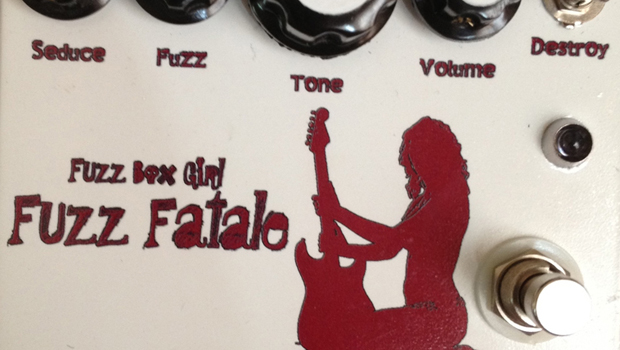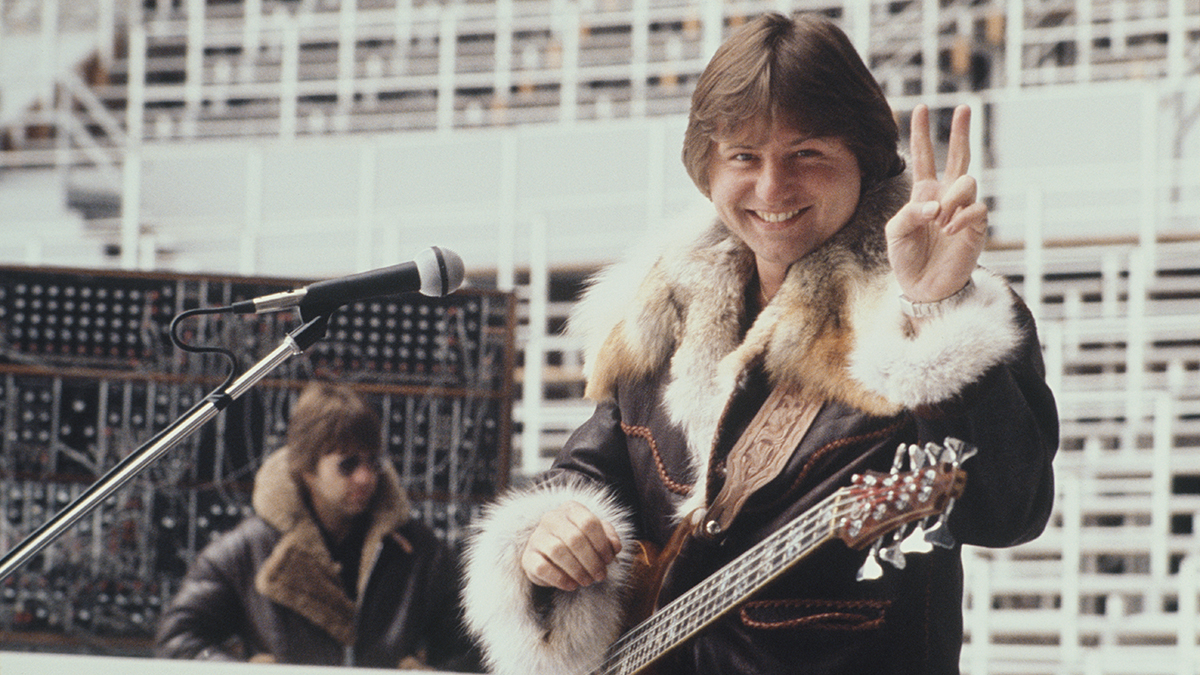Fuzz Box Girl Discusses Her New Signature Fuzz Pedal from God Box, the Fuzz Fatale

If you're a fan of YouTube gear demos, you probably already know who Fuzz Box Girl is.
We recently caught up with her to talk about her new signature fuzz pedal from God Box, the Fuzz Fatale.
GUITAR WORLD: What drove you to come up with your own signature fuzz pedal?
Carl Updegraff from God Box and I were talking one day about the possibility of me demoing some of his pedals. He wanted to do something special, so he had some special FBG graphics put on his God Complex, Tesla and Tesla 2 pedals. A week or so after I did my demo, Carl and I were emailing and he made the comment that if I ever wanted to do a limited FBG run of one of the pedals with my graphics on it or maybe some kind of signature fuzz to let him know, and I was like, "Well, funny you say that because I have had this idea for a pedal that I want for live gigs."
I didn't want to just bastardize one of the awesome circuits Carl had already made, so I wanted to come up with something new. After sending him all of my ideas and Carl sending me his ideas based on those ideas, we eventually came up with the Fatale.
Can you talk about the features of this pedal and what sets it apart from others?
Well, it's a collection of things, really. Firstly, the Seduce knob. It's a bit more than any regular old fuzz bias knob, and it's on the outside of the enclosure, instead of inside. Seduce allows you to reduce the voltage from 9v to about 4.5v. Why? Eric Johnson knows the secret to a great fuzz tone is to use a dying battery; a battery that is almost on its last legs. Even Duane Allman used a Fuzz Face with an old battery early in his career.
All the latest guitar news, interviews, lessons, reviews, deals and more, direct to your inbox!
Then there is the rotary dial. Carl uses this in his line of pedals and I thought it was just such an awesome idea, so I wanted one in the Fatale, but just dialed in a bit differently. Basically, the tone control allows you to change how the circuit reacts to the guitar signal by "hot swapping" input capacitors. The input capacitor is what determines the low-frequency response, thusly the amount of gain (good) and intermodulation distortion (not always good).
By allowing more or less low frequency into the circuit, the circuit acts in very different ways. As you can hear in the demos of the pedal (Check out the video), it'll go from a "tone bender" or "sparkle drive" type of bright sound to a very thick and sometimes synth-like sound. All of this is done by how much lows go into the circuit. Positions 2 to 4 and sometimes 5 are sometimes very subtle.
Carl specifically dialed these positions in to alter the fundamental frequencies of the guitar so that you can make more detailed choices. Positions 2 to 5 are where the guitar kind of lives and allows you to thicken up a thin sound, or brighten/tighten up a thick sound. Seriously, it is perfect tweakability for single coils or humbuckers or any rig configuration.
Another of my faves, the Destroy toggle was added to give the option of a more tame overall fuzz tone or an over-the-top, grunty, hairy fuzz. When the Destroy toggle is down, the circuit is very much like an over-biased Fuzz Face sound. When the toggle is up, symmetric silicon diodes are dropped into the circuit, which add in compression and more "hair." This is crucial when dialing in Superfuzz or a Big Muff-type tone.
A little more on the technical side, we have the transistors, which are two carefully chosen and matched up "world standard" HI GAIN silicon transistors for a stable and more "modern" approach to fuzz. And just for gigs, the LED is a fun feature in that the super-bright-red LED actually changes with the Seduce knob, giving you a visual indicator that something magical is happening.
Lastly, the Fatale will play "nice" with other pedals. Sure, I have a ton of different fuzz pedals, but I also have a lot of other effects. Many of us fuzz users know that a fuzz doesn't always play well with other pedals in a signal chain or even certain amps.
Are their plans for another run of the Fuzz Fatale pedals?
Carl and I have been discussing that. I mean, a big reason to do the limited run of Fatales was because it was an awesome way to help me out with my insane medical bills from a hit-and-run accident I had around Christmas. We could share the awesomeness of the Fatale AND the sales would help me out -- win win.
Carl and I have been going back and forth coming up with ideas for a production run of the Fuzz Fatales and to lower the price without really compromising the parts that make it the awesome fuzz that it is. So if we do a production run, they probably won't be mostly hand wired like the original run, but rather done with a PCB; it would have much more minimal graphics on just a metal enclosure, a few different internal components, and they just wouldn't come with any of the swag or personalization the first run came with.
Any plans for future signature pedals?
Well, like I've said to many people, I'm not really in the pedal business, you know? The Fatale has some sweet differences I feel do give it a place in the insanely overrun world of boutique fuzz pedals, which is one of the main reasons we decided to offer it. I have asked Carl about the possibility of making a versatile Fuzz Fatale octave fuzz, but other than that, I don't really have any plans to make another foray into the pedal biz.
For more about Fuzz Box Girl, check out her YouTube page.
Aaron Griffith is a gear-obsessed bassist/guitarist who has been obsessed with finding new ways to create guitar and bass tones as well as achieving complete and total sonic destruction of those tones for the last 25 years. He would scour guitar shows and pawn shops for hours on end looking for weird tone manipulators. You can read more at Signal To Noise.
